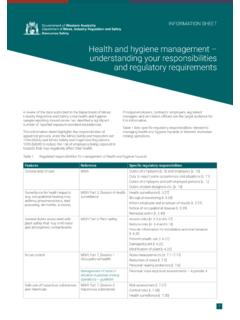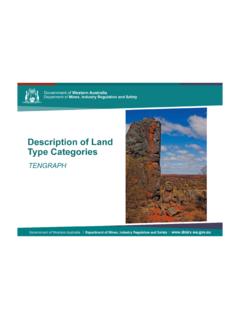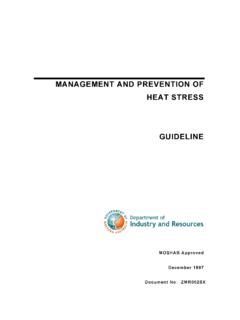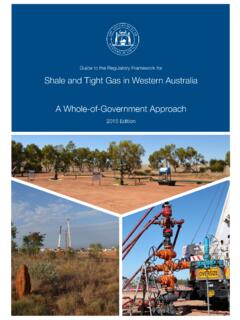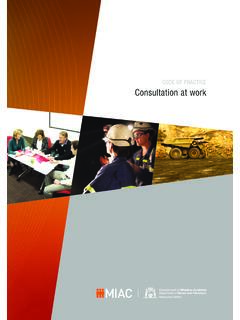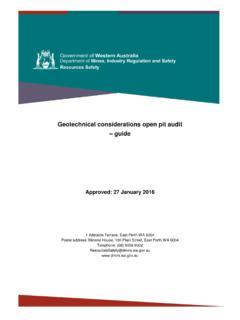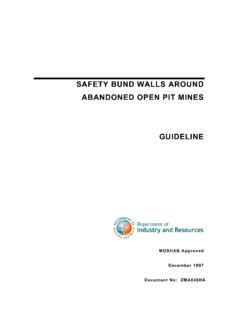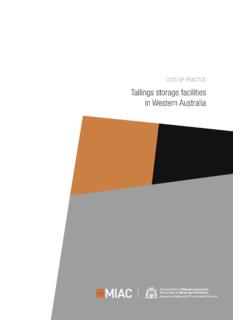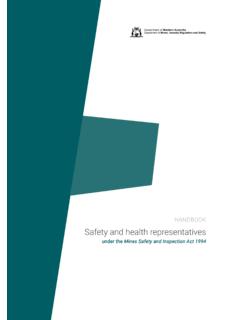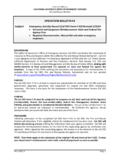Transcription of sulphide dust explosion - Department of Mines, Industry ...
1 SAFETY MANAGEMENT OF UNDERGROUND COMBUSTIBLE sulphide dust GUIDELINE MOSHAB Approved December 1997 Document No: ZMI578XC Department of Industry and Resources Document No. ZMT578XC Safety Management of UG Combustible sulphide dust CONTENTS PAGE LEGISLATIVE REQUIREMENTS (WA)..4 dust MINERALS OF Sulphur Content Of Common sulphide Air Toxic Oxygen ADDITIONAL CONTROL Ignition EMERGENCY Mine MINE Issued: December 1997 Page 1 Version Safety Management of UG Combustible sulphide dust Department of Industry and Resources Document No.
2 ZMI578XC FOREWORD This Department of Industry and Resources guideline has been issued to assist in identifying hazards and developing appropriate preventative strategies and training action plans to deal with the safe management of underground combustible sulphide dust . Adequate preventative strategies and the use and training of correct procedures is fundamental to the duty of care. It is emphasised that this guideline is not totally inclusive of all factors concerning the "Safe Management of Underground Combustible sulphide dust ," and that in some respects, it may not be totally suited to the individual requirements of susceptible mines. Comments on, and suggestions for improvements to the guidelines are encouraged. The guideline will be revised as appropriate to accommodate comments, as well as reflect legislative changes, new information, improvements in technology and operational experience.
3 Safety Health and Environment Division Department of Industry and Resources 100 Plain Street EAST PERTH WA 6004 TEL: (08) 9222 3333 FAX: (08) 9325 2280 INTRODUCTION Page 2 Issued: December 1997 Version Department of Industry and Resources Document No. ZMT578XC Safety Management of UG Combustible sulphide dust The Department of Minerals and Energy Safety bulletin No. 1 sulphide dust explosion Hazard February 1990, highlighted the concern for this problem. The hazardous nature of an uncontrolled sulphide dust Ignition (SDI), most likely an explosion , has been the subject of serious research only since the early eighties. It has also been the subject of a number of significant incident reports by mining inspectorates in Tasmania and New South Wales. This guideline applies to underground metalliferous mines and recommends precautions to be taken where there is a possibility of encountering pyro-sensitive sulphide dust .
4 Hazards created when a sulphide dust ignition occurs can include fire, toxic gases, oxygen deficiency and/or damage from an explosion . In recent years considerable research on SDIs ("dusties" to some) has been conducted by Dr Roger Enright of Sydney University. During the nineties this research was carried out in conjunction with Australian Mineral Industries Research Association Limited (AMIRA). The focus being to; identify how an ignition develops, evaluate current control methods, and develop appropriate control measures where possible. The team involved was successful in most of these areas. A new research program is underway to identify more practicable methods of control. The incidence of reported sulphide dust ignition occurrences in mines in Western Australia is very low. World wide, over the last 20 years there has been an increasing incidence of SDI explosions which appears to coincide with the increasing use of larger hole diameter blasting.
5 Of particular concern is vertical crater retreat (VCR) mining. This guideline has been compiled from documents referenced in the Appendix, reviews of mining practice, and consultation and interaction between the Inspectorate and Industry . It should be noted that other mining dusts which may ignite and explode are not covered by this guideline. LEGISLATIVE REQUIREMENTS (WA) Issued: December 1997 Page 3 Version Safety Management of UG Combustible sulphide dust Department of Industry and Resources Document No. ZMI578XC Regulations contained in the Mines Safety and Inspection Regulations 1995 which are relevant to underground mines subject to sulphide dust ignitions are: Specific emergency precautions required to be taken for underground mines (1) This regulation applies to any of the following potential incidents - (a) a fire; (b) an accidental explosion (including a sulphide dust or coal dust explosion ); (c) a failure of the primary ventilation system; (d) flooding; (e) an inrush of mud or tailings; (f) an inrush or outburst of gas; or (g) the extensive collapse of workings.
6 (2) The principal employer at, and the manager of, an underground mine must ensure that, so far as is practicable, the following things have been done to ensure the safety of persons working underground in the mine in the event of a potential incident to which this regulation applies - (a) An alarm system has been installed and a procedure has been established for activating the system; (b) A procedure has been established for the prompt notification of rescue and fire fighting teams; (c) A procedure has been established for evacuating persons working underground; (d) Fire refuge chambers and fresh air bases are provided for persons working underground; (e) Provision has been made for the safety of drivers of winding engines at underground shafts; (f) All employees are adequately trained and retrained in emergency procedures and the use of emergency equipment and facilities; and (g) Emergency drills have been conducted on a regular basis.
7 Penalty: See regulation Self rescuers in underground mines (1) The manager of an underground mine must ensure that any person who goes underground in the mine - (a) Is provided with (at least) a filter self rescuer or (preferably) a self contained self rescuer; and (b) Is fully trained in the use and limitations of the self rescuer provided. Penalty: See regulation (2) If there is a risk of a dust explosion or an identified risk from naturally occurring noxious or asphyxiant gases in an underground mine, the manager of the mine must ensure that all persons who go underground in the mine are provided with self contained self rescuers. Penalty: See regulation Page 4 Issued: December 1997 Version Department of Industry and Resources Document No. ZMT578XC Safety Management of UG Combustible sulphide dust (3) A person in an underground mine must not - (a) Wilfully damage a self rescuer; or (b) Use a self rescuer for a purpose other than the preservation of life or to demonstrate how it works.
8 Penalty: See regulation Monitoring of toxic, asphyxiant and explosive gases (1) Each responsible person at a mine must ensure that adequate precautions are taken to monitor, and control the risk from, the formation or emission of toxic, asphyxiant and explosive gases in the mine. Penalty: See regulation (2) If gases such as hydrogen cyanide, hydrocarbons, carbon dioxide, radon, sulphur dioxide, hydrogen sulphide , carbon monoxide, or methane are likely, suspected or known to be generated or emitted in a mine, the manager of the mine must ensure that the district inspector and employees at the mine are notified of the precautions that have been taken to monitor, and control the risks from, those gases. Penalty: See regulation (3) The manager of an underground mine must ensure that, in any workplace in that mine, the atmosphere does not contain more than 12500 ppm, or by volume, of methane. Penalty: See regulation (4) If in any operation at a mine toxic, asphyxiant or explosive gas is emitted into the atmosphere in any travelway or other workplace, the manager of the mine must ensure that, where practicable, a monitoring device or monitoring devices are installed in the mine to give adequate warning of when the peak or STEL level of gas concentration is being approached.
9 (5) If any monitoring device is installed as provided in subregulation (4), the manager of the mine must ensure that adequate notices are erected in or about the mine informing persons of - (a) The meaning of the warnings given by the device; and (b) What action is required to be taken in the event of any such warning being given by the device. Penalty: See regulation sulphide dust ignitions The manager of an underground mine in which minerals in the form of sulphides are present must ensure that - (a) The risk of sulphide dust ignition is thoroughly evaluated before mining operations commence at the mine; Issued: December 1997 Page 5 Version Safety Management of UG Combustible sulphide dust Department of Industry and Resources Document No. ZMI578XC (b) procedures and work practices are developed and followed that minimise the risk of an explosion ; and (c) procedures are developed and followed that prevent injury or harm to the health of any person in the event of a sulphide dust ignition following blasting.
10 Penalty: See regulation dust EXPLOSIONS Many common dusts are combustible and with the right set of circumstances are explosive. It is worth noting that dusts generated from a large range of agricultural products feature prominently on the list. Some mineral dusts are also a major concern and when encountered in an underground mine the hazard is an order of magnitude higher. Of particular interest in mining is the uncontrolled combustion of sulphide and coal dusts. Dr Enright describes a dust explosion as essentially a very rapid combustion of a suspension of fine particles, during which heat is generated at a higher rate than is dissipated to the surroundings. This phenomenon is characterised by the sudden development of pressure and a flame front which can cause loss of life and extensive destruction of plant and equipment.
